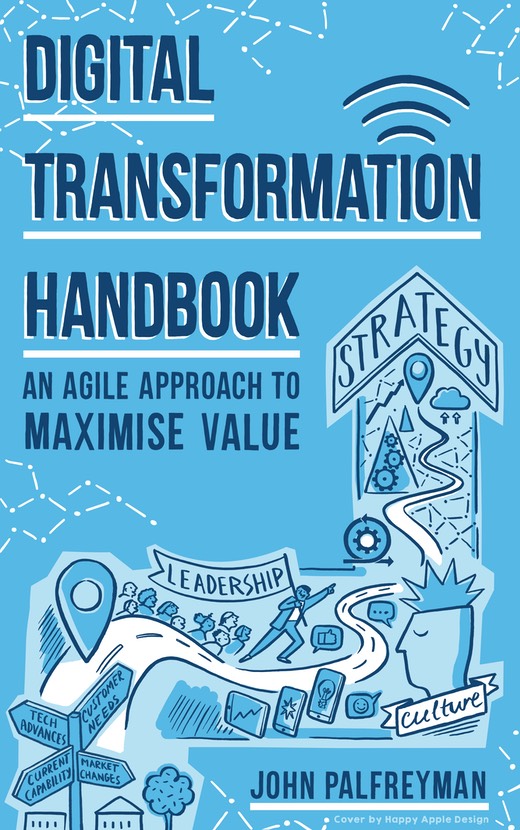
I’m now using LinkedIn for the majority of my blog posts. Here are a few that I hosted on my own site.
Realising Citizen-centric Identity
Imagining a World Where Losing Your Driving License is no Longer a Nightmare!
Co-authored with Dr. Julia Glidden, IBM Global Government
Digital disruption has changed the way we think about our identity. From Amazon’s ‘tell it once’ payment service through to Facebook’s federated single sign solution, more and more of us are embracing the notion of self-authenticating against a trusted online source of our choosing. Why? For the simple reason that doing so makes our lives easier.
Contrast this trend with government issued identity. From birth certificates and social security cards through to driving licenses and passports they’re all paper based. Many – especially older ones like birth certificates - are often hard to track down and obtain. Meanwhile, losing the physical document itself is often a time consuming, bureaucratic nightmare. Just as bad, who hasn’t shook their head in frustration after being asked to input the same information - name, address, date of birth – over and over again on government forms?
It goes without saying that there’s a growing gap between the demand for Digital Identity, on the one hand, and the limitations of Government issued identity, on the other. Citizens want the ease, convenience and control that self-generated digital identity provides. Similarly, identity consumers - from banks through to government itself - want to make it as quick and easy as possible for people to access their services. At the same time, however, these organisations also need to ensure our data protection and privacy whilst reducing fraud and identity theft – requirements which, thus far, have necessitated Government issued identity.
Enter blockchain – a rapidly emerging technology that addresses the central need for trust, efficiency and security in the identity space.
Blockchain is a technology platform which sits on top of the Internet and makes the exchange of data vastly more efficient through the creation of a distributed ledger (or system of record) that runs across a peer to peer network. In a blockchain, transactions are agreed by appropriate members of the network before being committed into time-ordered “blocks of information.” These blocks are then bound together in a ‘chain’ via privacy services, including cryptographic hashing and consensus algorithms. Finally, a pre-agreed smart contract between network members authorises access over who can see what information by encoding the conditions for access or update, and then automatically executing the event when the conditions are met. The combination of a distributed ledger, privacy controls and smart contract provides total clarity as to who’s done what and when within the blockchain, making it inherently resilient to failure, fraud and cybercrime whilst putting the citizen in control of who can access their identity and when.
But the good news doesn’t stop here. Because a blockchain-based identity is constructed online, it’s also easily transportable. IBM, for example, recently teamed up with Canadian solution vendor SecureKey to build an identity solution on top of the Linux Foundation Hyperledger Blockchain Fabric that enables citizens to establish and register their identity and then control usage through an easy-to-use mobile app:
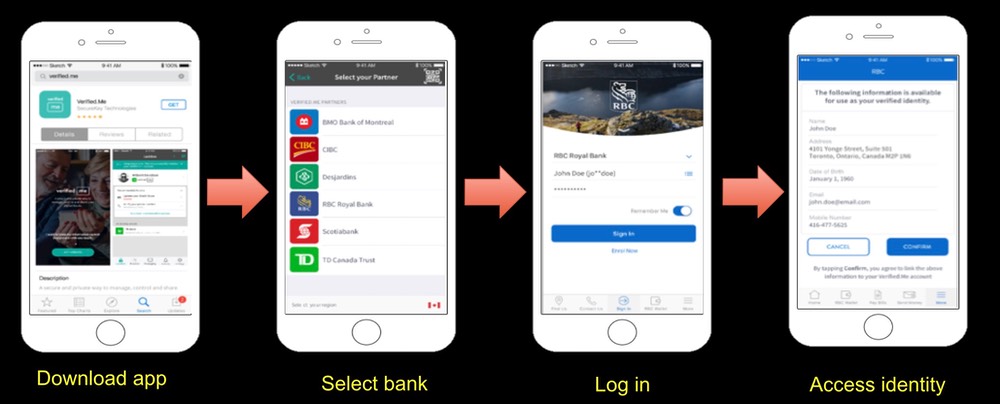
The two companies then demonstrated this capability in conjunction with the Canadian Government and a network of banks and telecommunications providers. To the surprise of few, they found that the solution benefits all parties. Citizens only need to enter personal information once. After doing so, they can use the smart contract to control access to this information and monitor who’s seen which parts, when and for what purpose. The distributed nature of blockchain ensures that there is no single target for the cybercriminal, whilst the privacy services not only guarantee that information is kept private - even from the network operator – but also empowers citizens to ask to be forgotten and verify that they actually have been.
Meanwhile, a mobile app based blockchain identity enables identity consumers to have the same assurance that a person is who they say they are as a traditional government issued identity without the need for cumbersome paper-based forms, online registries and multiple data entries. At the same time, the Privacy Services and Smart Contract enable them to access just enough information to verify identity without compromising the security and integrity of personal customer data.
But the potential benefits don’t stop there. Once the notion of blockchain Citizen Identity takes off it becomes entirely possible to imagine a world in which a citizen is literally able to build, control and maintain a complete and trusted audit trail of their own life journey - from birth through to death – and can carry it with them on a smart phone. If a citizen chooses, everything from registry of birth through to travel records, educational certificates and employment history can be uploaded to a blockchain, creating a secure, complete and easily accessible digital identity which they can control throughout their lives.
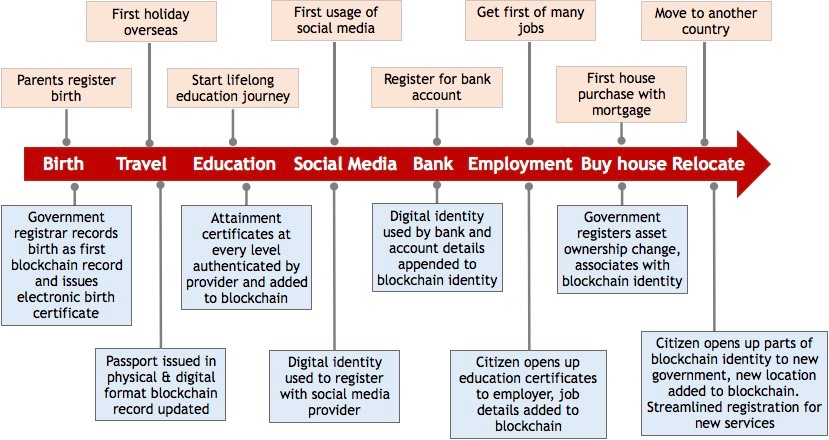
Sound futuristic? It isn’t. Government everywhere can help kick-start the journey by taking a few pragmatic steps to explore the application of blockchain-based identity for their own citizens:
[1] Get to grips with the fundamentals of distributed ledger technology by accessing (free to use) online education: https://developer.ibm.com/blockchain/
[2] Understand how blockchain can build trust in citizen interaction and remove bureaucracratic barriers within government by accessing resources from IBM Institute for Business Value: http://bit.ly/TrustBC
[3] Understand government led consortium building initiatives to address the identity challenge such as the Canadian DIACC: https://diacc.ca
[4] Use Design Thinking to understand the challenges of your specific government: https://www.ibm.com/design/thinking/
[5] Start a small blockchain pilot project to acquire “hands on” experience of the technology’s transformation value: https://www.hyperledger.org/projects/fabric
It’s still early days for blockchain to be sure. And there remains much work to be done to bring our vision of a blockchain-based digital Identity to reality. But one thing is certain: for citizens and businesses to reap the full potential of this transformative technology we need more visionary government around the world have to see the same potential in the identity space as Canada, support networks of their own and exchange best practice. The blockchain Identity train has left the station, as the saying goes. But it won’t stay on track and arrive at the desired destination without continued government leadership and commitment.
Combating Electric Bike Theft with Blockchain
I often get asked about a good example of a blockchain use case that is easy to understand, where the blockchain value add is obvious. How about this one . . .?

Every time I go into a bike shop these days, there is an increasingly impressive array of electric bikes. I’m not sure what amazes me more - the technical features, or the price tag! So theft is a big issue. One can buy a smart locks to remotely track and secure bikes. This both provides an opportunity for better theft prevention and enables business models for bike rental. A better bike registration system is needed to share ownership information and that puts the bike owner in control.
The Netherland Vehicle Licencing Agency (RDW) and IBM have developed an electric bike registration proof of concept based on blockchain technology, which they call BikeBlockchain.
Bike owners can prove their ownership and report the bike stolen through a blockchain enabled application. The smart lock on the bike registers the position of the bike, which is recorded onto the blockchain when the lock is activated. When a bike is stolen the police are able to see the latest position to respond instantly. Insurance companies can use smart contracts to automate their claim handling processing making this much more reliable and efficient.
The business network, and their interaction with the blockchain is shown in the following figure.
This is a proof of concept at this stage, but shows blockchain in action with an innovative new approach to a real problem!
Thanks to IBM & RDW for excellent source material!
Creating a Culture for Open Innovation
The Vonlanthen Group had the foresight to organise a two day summit in Barcelona bringing together delegates from across a wide range of industries to discuss this fascinating topic. I had the honour of delivering a keynote outlining how blockchain can underpin open innovation and then moderate the first day. I offer a few reflections on what I learnt, focusing on the cultural blockers and enablers for Open Innovation.
I first came across Open Innovation around 2005, recognising that the work of Prof. Chesbrough could greatly enhance an organisation’s ability create value by combining their ideas with those from across their network of collaborators as shown in Figure 1.
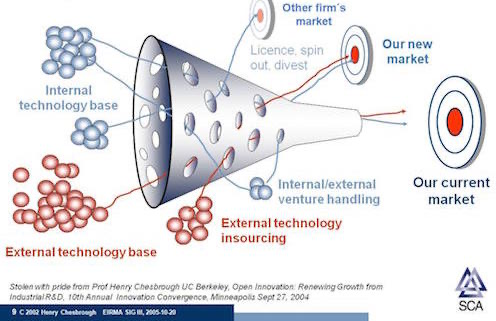
Figure 1 - The Open Innovation Funnel
Open Innovation runs counter to more tradition (or closed) methods for organisational development as shown in Table 2.
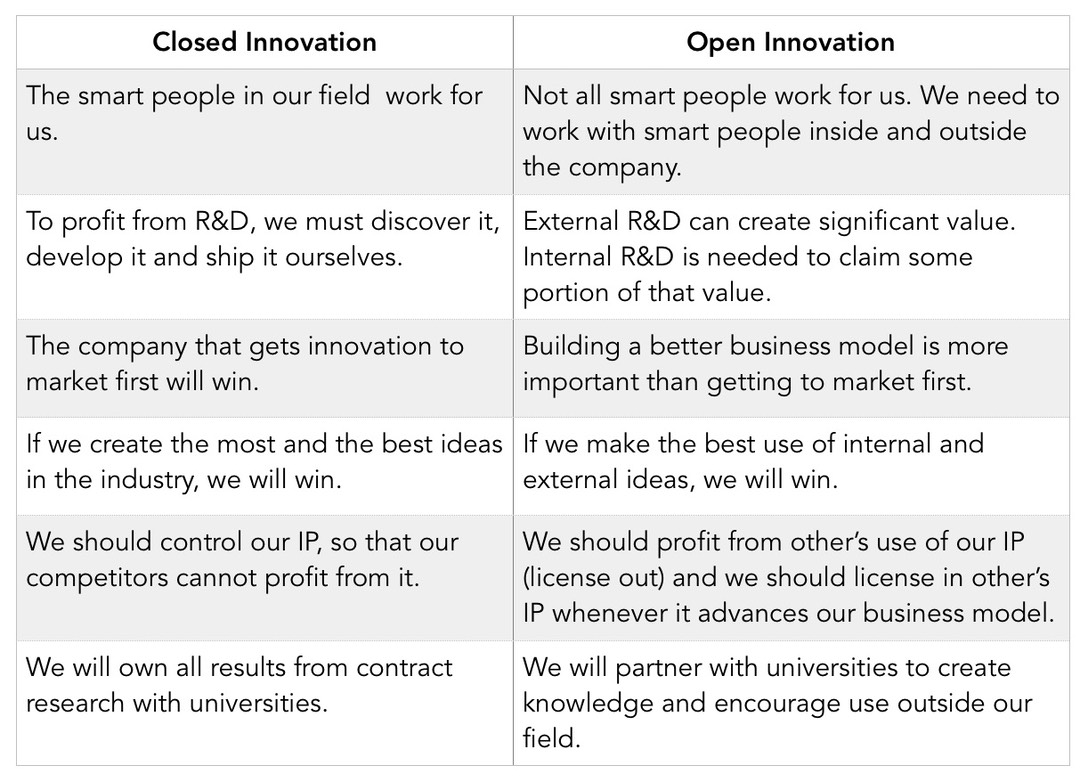
Table 2: Open versus Closed Innovation
Is the technology ready?
I am increasingly convinced that the technical platforms for Open Innovation exist and are not an impediment for an organisation wishing to use the method to transform and grow. These platforms are also not new. The open source software community as an example has embraced remote collaboration tools to structure and coordinate their efforts for many years. Platforms such as IBM Connections or Google G Suite allow organisations to come together and can facilitate Open Innovation initiatives.
As organisations embrace blockchain for business, the increased trust that this emerging technology can offer takes Open Innovation initiatives to the next level. Blockchain allows organisations to come together and implement a common business process with increased levels of trust, controlled transparency and a complete tamper proof audit trail of who’s done (or owned what), when. Informed and appropriate use of blockchain can considerably enhance the levels of trust between organisations committed to Open Innovation as a way of transforming together.
So I would argue the technology IS READY and improving all the time.
Cultural climate
Now for the hard part! The culture needs to be right for Open Innovation to work. The Barcelona summit was excellent at bringing together organisations who were already embracing Open Innovation and getting considerable sustained advantage from so doing with those using more traditional innovation approaches and wishing to change. It thus presented an excellent learning opportunity for all delegates. It also re-enforced my hypothesis that:
(1) Creation of the right cultural climate is an essential pre-requisite for Open Innovation to move from a nice theoretical model to adding real, sustained business value and
(2) Cultural change can only be slow, incremental, very hard to achieve in practice and needs strong leadership.
There are some excellent examples of Open Innovation in action, and these were the focus of case study presentations at the summit. In my keynote, I highlighted the Linux Foundation Hyperledger Project as an exemplar for cross industry Open Innovation in action. The project is building a blockchain fabric - or middleware - essentially the “plumbing” needed for a blockchain solution. The project adopted three key “open” tenants of the Linux Foundation, specifically:
Open Source - the source code developed would be available to all to use, subject only to an open source licence licence agreement
Open Standards - to ensure the eventual interoperability of blockchain solution moving away from the “one (block)chain to rule them all” approach used by some other blockchain fabrics
Open Governance - ensuring the project direction and technical decisions represent the interest of all members. This ensures that the fabric is suited to the needs of all project sponsors, and not optimised for one organisation or a specific industry.
Since it’s formation in December 2015, the Hyperledger Project has been THE fastest growing Linux Foundation initiative with over 150 members now embracing five sub-projects and three tool builds at the time of writing.
It’s interesting to speculate on the cause of this success. Clearly the members have a shared goal of having a blockchain fabric optimised for business and are happy to contribute funds, effort and / or source code to realise their goal and understand the transformational potential that blockchain offers to their organisation. No better driver to generate the right cultural climate for Open Innovation to flourish!
Understanding culture blockers / enablers for Open Innovation
When different organisations come together to embrace Open Innovation to transform, its essential to understand their business drivers and potential inhibitors to the collaboration. The four box model shown in Figure 3 is a useful framework for this analysis.
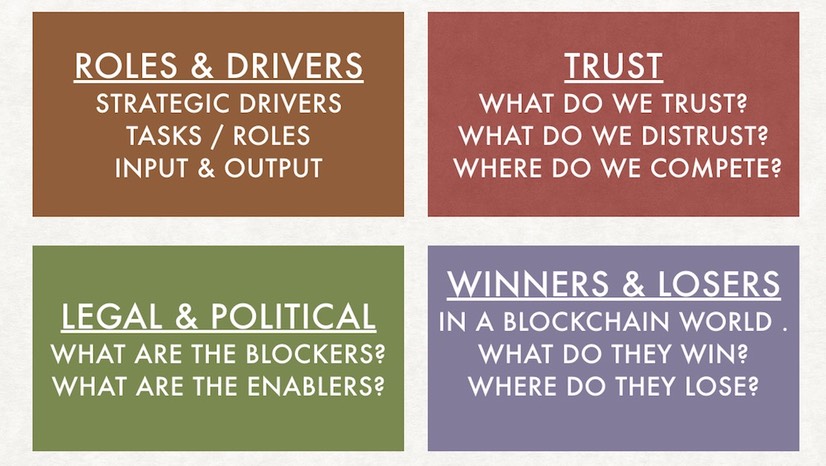
Figure 3: Four Box Framework
In a facilitated workshop involving all core business network members we need to work through these four fundamental considerations in an open and considerate fashion. Some of these discussions - especially in the “trust” and “winners & losers” categories - will be hard and will require careful and sensitive facilitation BUT are essential to understand then work through the cultural challenges to ensure that Open Innovation can add the most value to organisations wishing to transform.
[http://bit.ly/OICulture]
Ten blockchain project pitfalls - and how to avoid them!
This blog post is based on my work on IBM blockchain customer projects over the past two years. I have kept each section short, and risk management oriented, but I hope this will give some practical suggestions to anyone starting embarking on an exciting blockchain journey!
[1] Know your blockchain from your bitcoin? Risk – confusion arising from familiarity with bitcoin and non-permissioned ledger then not fully understanding permissioned blockchain for business networks.
Mitigation – self-educate (this recent blog post is excellent) then don’t skip the early awareness steps and /or important education. I warmy recommend this Blockchain Essentials course!
[2] Project, or technology sand box? Risk – project is (only) sponsored by technologists and is lacking in a clear business transformation goal.
Mitigation – clear, passionate business sponsorship and quality input through the Design Thinking workshop and to guide and prioritize solution features across agile sprints.
[3] More than can be chewed? Risk – initial use case is unsuitable either for the emerging nature of the blockchain technology and / or the customer’s level of blockchain awareness
Mitigation – start small by choosing the right starter use case, or “corner” of bigger use case. Get hands on awareness and experience then grow fast.
[4] Blockchain value, or religion? Risk – the constant hype can confuse us into thinking blockchain is the solution to all problems (and then some!).
Mitigation – Read the “10 things that blockchain IS NOT” blog then test blockchain fit (Network + Consensus | Immutability | Provenance | Finality) early and continue to test during design thinking process.
[5] Talk agile, walk waterfall? Risk – many of us have grown up with waterfall development. It’s in our DNA. So, we talk about agile sprints, scrums, MVPs and backlog prioritization but are expecting delivery against a fixed list of requirements in a set given timescale.
Mitigation – be open minded if agile is a new experience, be guided by the skilled practitioners, provide clear guidance at the sprint demos and learn as we go!
[6] Shared, business network clarity of purpose? Risk – it’s easy to get carried away by an exciting blockchain first project. But are all the network members really of the same mind on the transformational goals? Is the value for all members clear and accepted?
Mitigation – business network members participate in Design Thinking Workshop thoroughly understand the use case and debate their accrued value (being selfish, as needed) until it’s totally clear. Business network members agree a governance approach for all aspects of network operation.
[7] Easy to discuss cooperation, harder to make transformation. Risk – business network members discuss details of how they currently work together rather than focusing on the transformational opportunity.
Mitigation – don’t rush things - allow time for discussion but through sensitive facilitation and a clear, proven design thinking approach guide the discussions into persona analysis, current methods of working and opportunities for improvement.
[8] We already know what we want, why waste time with Design Thinking? Risk – business network members spend time formulating a requirement and describing “to be” customer journeys so reluctant to invest time in a design thinking workshop.
Mitigation – offer a (slightly) accelerated persona-led design thinking session culminating in hill definition to validate and expand on earlier work. This will give clarity of guidance for development team, and a clear explanation of value to the stakeholders.
[9] Do we really know this business challenge? Risk – project (especially workshop) participants don’t have a deep enough knowledge of the business problem to guide the development process.
Mitigation – make sure customer participants in the workshop – and ongoing project – are able to describe how the current systems are used, and explain the challenges of using them.
[10] Who’s project is this anyway? Risk – vendor subject matter expert speaks for the customer, filling “thought vacuums” with their wise words. Results in lack of customer ownership of project and likely ultimate demise.
Mitigation – brief all vendor project participants on this danger and ensure they know the importance of allowing the customer time and space to think, explain and ultimately own!
[http://bit.ly/BlockPitfall]
